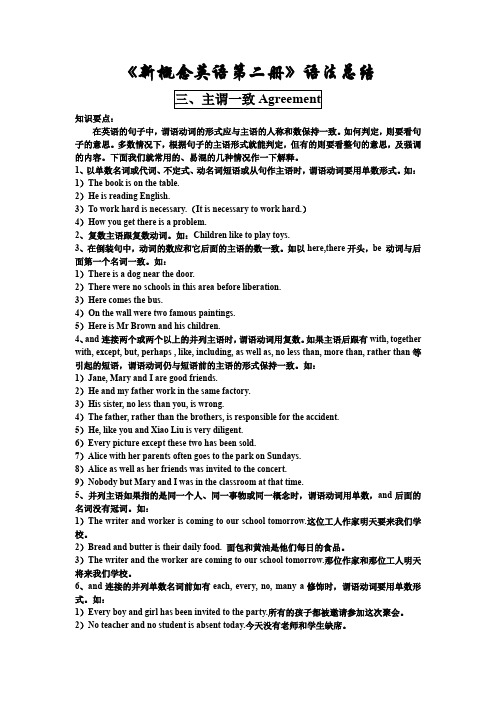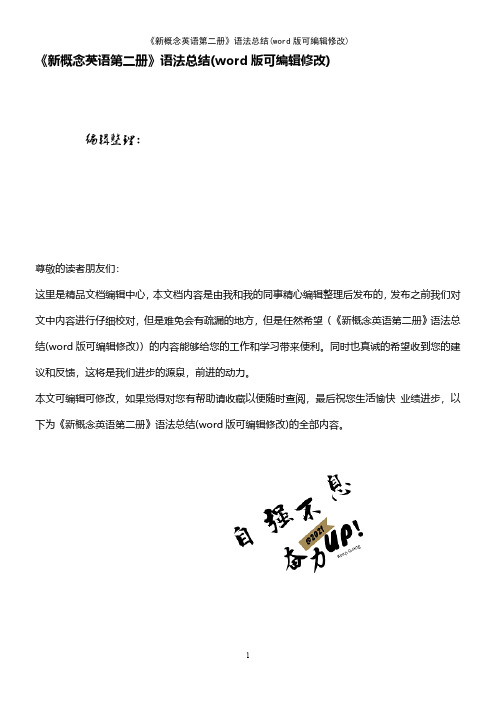新概念英语第二册语法锦集【三篇】
- 格式:docx
- 大小:41.27 KB
- 文档页数:8

《新概念英语第二册》语法总结知识要点:在英语的句子中,谓语动词的形式应与主语的人称和数保持一致。
如何判定,则要看句子的意思。
多数情况下,根据句子的主语形式就能判定,但有的则要看整句的意思,及强调的内容。
下面我们就常用的、易混的几种情况作一下解释。
1、以单数名词或代词、不定式、动名词短语或从句作主语时,谓语动词要用单数形式。
如:1)The book is on the table.2)He is reading English.3)To work hard is necessary.(It is necessary to work hard.)4)How you get there is a problem.2、复数主语跟复数动词。
如:Children like to play toys.3、在倒装句中,动词的数应和它后面的主语的数一致。
如以here,there开头,be 动词与后面第一个名词一致。
如:1)There is a dog near the door.2)There were no schools in this area before liberation.3)Here comes the bus.4)On the wall were two famous paintings.5)Here is Mr Brown and his children.4、and连接两个或两个以上的并列主语时,谓语动词用复数。
如果主语后跟有with, together with, except, but, perhaps , like, including, as well as, no less than, more than, rather than等引起的短语,谓语动词仍与短语前的主语的形式保持一致。
如:1)Jane, Mary and I are good friends.2)He and my father work in the same factory.3)His sister, no less than you, is wrong.4)The father, rather than the brothers, is responsible for the accident.5)He, like you and Xiao Liu is very diligent.6)Every picture except these two has been sold.7)Alice with her parents often goes to the park on Sundays.8)Alice as well as her friends was invited to the concert.9)Nobody but Mary and I was in the classroom at that time.5、并列主语如果指的是同一个人、同一事物或同一概念时,谓语动词用单数,and后面的名词没有冠词。

新概念2语法汇总新概念二册语法点汇总L.11.五大基本句型2.零冠词精讲背诵L.21.现在进行时与一般现在时2.感叹句的基本结构精讲L.31.“给予”动词带双宾精讲背诵L.41.现在完成时2.Accept vs.receive3.excited vs. exciting知识点和第五课重复,可以不讲L.51.一般现在时与过去完成时的区别2.In 3 minutes vs. in 3 minutes’ time3.带way的短语精讲课文:背诵课文L.61.in vs.on2.不定冠词的一般用法3动词词组搭配精讲课文:背诵L.71.expect的用法2.过去进行时3.When, while and as4.小品词(副词vs介词)精讲L.81.形容词和副词的比较级和最高级2.谓语动词的单复数确定精讲:背诵L.91.根本工夫介词的用法:at, in, on, during, through, till, until2工夫透露表现法次精讲L.101.被动语态2.名词所有格,双重所有格(37)3.made in, made of, made from, made by精讲;鼓励背诵,加强语感L.111.deserve的用法2.不定式作宾语动词后是不是需求先加一个名词或代词次精讲:得当背诵L.121.一般将来时可以不讲L.131.将来进行时和一般将来时的区别精讲L.141.Except, except for, apart from次精讲L.151.afford的用法2.interrupt的用法3.直接引语与间接引语精讲:背诵L.161.Remind的用法2.Fail的用法3.if条件句精讲:背诵L.171.in spite of2.介词的用法in,3情态动词精讲:鼓励背诵L.181.have的多种用法(助动词,完全动词)2.关于give的词组自学课文L.191.hurry的用法2.Can vs may; can vs could; may vs might3. might as well 次精讲:设置场景,组对背诵L.201.动名词充当主语和宾语2.Instead of vs. instead精讲:背诵L.211.含助动词的被动语态2.Come into3.drive的不同用法4.Home vs. house次精讲L.221课后介词搭配操演文章次精讲L.231.there is vs. it is自学课文L.241温,主如果课后操演XXX:勉励背诵L.251并列句选择or/either…or…/XXX推论XXX原因for精讲:背诵L.261.pretend的用法2.Appreciate的用法3.Hang的用法4.哪些动词不合用于进行时次精讲:勉励组对背诵L.271.关于put的词组2 and引导的并列句次精讲L.281.现在完成时(现在完成时+since/ever since;最高级句+现在完成时;have been to vs.have gone to)2 it is one of the ugliest faces I have ever seen次精讲:现在完成时L.291 called初步引导定语从句省略2 the most surprising thing about it is that …表语从句精讲:背诵课文L.301.towards的用法2.定冠词的用法3 there were some people doing sth.4 so…that…次精讲L.31ed to do/be used to/get used to2过去完成时,过去进行时精讲课文:鼓励背诵,加强语感L.321.描述词同级比力(as…as),than usual2一段工夫以后,产生别的一件事。

新概念英语第二册语法精粹及练习(一)新概念二册语法精粹一、一般现在时一、一般现在时:1.构成:使用动词原形,第三人称单数须有变化。
(1)直接加“s”,works,takes(2)以辅音加“y”结尾,变“y”为“i”,再加“es”,carry → carries(3)以“o, s, x, ch, sh”结尾的动词加“es”, goes dresses watches brushes2.功能:(1)表现在的事实、状态或动作:eg: Birds fly.She loves music.Mary's parents get up very early.(2)表习惯性动作或职业,常与often,sometimes,usually,always,every week,seldom,occasionally,frequently等时间副词连用。
eg: I always take a walk after supper.She writes to me very often.Tom and his girlfriend go out to take a picnic occasionally.(3)表客观真理,格言警句或事实:The earth moves round the sun.The sun rises in the east and sets in the west.Two and two makes four.No man but errs. 人非圣贤,熟能无过。
(4)表将来:A.在由when,after, before,as,as soon as,although,because,if,even if,in case,till,until,unless,so long as, where, whatever,wherever 等引导的状语从句中用一般现在时表将来发生的动作。
(黄金重点,所有考试都不放过它!)例如:I'll tell her when shecomes tomorrow.Even ifit rains this afternoon, I'll meet you.Whatever happens, you should keep cool-headed. (不错的句型,背下!!)I'll be right here waiting for you wherever you go.(很感人的句型!)B.按时间表示将要发生的动作或事件,用一般现在时表达将来时概念。


新概念第二册各单元的语法要点归纳第一单元 - 学外语的好处- 句型:It is (not) + 形容词 + (for somebody) + to do something - 示例:It is important for us to learn a foreign language.- 句型:It is said/believed/thought/reported that ...- 示例:It is reported that English is spoken all over the world.第二单元 - 生活在一个大城市- 句型:There be + 名词(单数/复数)+ (地点)- 示例:There is a park near my house.- 句型:What color/size/shape + be + 主语?- 示例:What color is your car?第三单元 - 海底勘探- 句型:现在进行时(be动词 + 动词ing)- 示例:They are looking for oil under the sea.- 句型:需要/应该/可以/能够 + 动词原型- 示例:We can use machines to explore the ocean floor.第四单元 - 名人的生活- 句型:情态动词 + 动词原型- 示例:She can sing very well.- 句型:主语 + be + 形容词 + to do something- 示例:Be patient to wait for your turn.第五单元 - 健康与健身- 句型:情态动词 + 动词原型- 示例:You should exercise regularly.- 句型:主语 + need(s) + to do something- 示例:We need to eat a balanced diet.第六单元 - 书信写作- 句型:谓语动词 + 宾语 + 动词-ing- 示例:I enjoy reading books.- 句型:It is + adj. + of + somebody + to do something - 示例:It is kind of you to help me.第七单元 - 未来生活- 句型:将来时态(will/shall + 动词原型)- 示例:We will have robots to do household chores.- 句型:It is + adj. + that + 从句- 示例:It is certain that technology will change our lives.第八单元 - 代购- 句型:情态动词 + be + adj. + to do something- 示例:I must be careful not to buy counterfeit products. - 句型:主语 + be + 形容词 + of + 宾语- 示例:The article is full of useful information.第九单元 - 旅游- 句型:现在完成时态(have/has + 过去分词)- 示例:I have visited many cities in Europe.- 句型:It is + adj./adv. + that + 从句- 示例:It is true that travel broadens the mind.。

完整版)新概念第二册语法重点汇总一览表New Concept 2 Grammar SummaryLesson 1: Simple Word Order in Declarative Sentences。
Present Simple and Present Continuous Tenses。
Present Perfect Tense。
Direct and Indirect Objects.Lesson 2: Differences een Present Perfect and Past Simple Tenses (1)。
Differences een Present Perfect and Present Continuous Tenses。
Appositive.Lesson 3: Phrasal Verbs。
Past Continuous Tense (1)。
Uses of a。
the。
and some.Lesson 4: ns in Phrasal Verbs。
ns of Time。
Past Continuous Tense (2).Lesson 5: Comparatives and Superlatives of Adjectives and Adverbs。
Passive Voice。
XXX: in。
on。
at。
during。
till。
and until。
Two Forms of Negative Sentences: not any and no.Lesson 6: Passive Voice in Present and Past Continuous Tenses。
Double Possessive.Lesson 7: XXX with to。
Future Simple Tense。
Future Continuous Tense.Lesson 8: Past Perfect Tense。
《新概念英语第二册》语法精粹一、冠词The Article知识要点:冠词是一种虚词,放在名词的前面,帮助说明名词的含义。
冠词分不定冠词(The Indefinite Article)和定冠词(The definite Article)两种。
a (an) 是不定冠词,a用在辅音之前:如a book, a man; an用在元音之前,如:an old man, an hour, an interesting book等。
the是定冠词。
一、不定冠词的用法1、指人或事物的某一种类(泛指)。
这是不定冠词a (an)的基本用法。
如:She is a girl. I am a teacher. Please pass me an apple.2、指某人或某物, 但不具体说明何人或何物。
如:He borrowed a story-book from the library.A Wang is looking for you. 一位姓王的同志正在找你。
3、表示数量,有“一”的意思,但数的概念没有one强烈。
如:I have a mouth, a nose and two eyes.4、用于某些固定词组中。
如:a bit, a few, a little, a lot of, a piece of, a cup of, a glass of, a pile of, a pair of, have a good time, for a while, for a long time等。
5、用在抽象名词前,表具体的介绍——a + 抽象名词,起具体化的作用。
如:This little girl is a joy to her parents. 这女孩对她父母来说是一个乐趣。
It is a pleasure to talk with you. 跟您交谈真是一件愉快的事情。
It is an honour to me to attend the meeting. 参加这个会,对我来说是一种荣誉。
新概念英语第二册语法总结:五种基本句型第一篇:新概念英语第二册语法总结:五种基本句型新概念英语第二册语法总结:五种基本句型1.主+谓(不及物动词)e.g.Man can think.The fire is burning.常用不及物动词有break, breathe, burn, smoke, swim, skate, appear, disappear, work, think etc.2.主+谓+表语(系动词)e.g.He became a scientist.She is getting more and more beautiful.常用系动词: be, get, turn, feel, seem, appear, look, taste, sound, smell, become, go, prove etc.3.主+谓+宾(及物动词)e.g.We love peace.They will paint the door.常用动词有:see, watch, need, love, like, study, answer, carry, etc.4.主+谓+宾+宾补e.g.We elected him president.They painted the door white.I advised the students to recite the texts.王牌重点:常用作宾补的形式(1)名词:The couple named their baby Johnson.(2)形容词:I keep the door open.(3)副词:The naughty boy knocked the bottle over.(4)不定式:He ordered his men to fire.(5)分词:He heard me singing.I saw the vase broken.(6)介词短语:They look on him as a teacher.(7)名词性从句:I asked him what he was doing.5.(1)主+谓+间接宾语+直接宾语My friend bought me a gift.I passed him the book.(2)主+谓+直宾+介词+间宾My friend bought a gift for me.常与介词 for 搭配的动词有:buy, make, do, get, play, call, choose, cook, fetch, find, keep, order, save, etc.常与介词 to 搭配的动词有:bring, give, grant, hand, pass, lend, offer, pay, promise, sell, send, show, each, tell, throw, write, etc.第二篇:新概念英语第二册语法总结新概念英语二册语法详解和总结《一、学习前的准备《新概念英语第二册》旨在全面训练学生的4项技能、理解、口语、阅读、写作。
2.一般现在时,现在进行时感慨句:what+名词+主语+谓语,how+形容词/副词+主语+谓语频度副词:位于主语和谓语之间,常见频度副词及其程度的深浅:always, often, usually, frequently, sometimes, hardly, rarely, seldom, neverI always buy CDs on Sundays.3.一般过去时直接宾语和间接宾语:主语+及物动词+间接宾语+直接宾语直接宾语是及物动词的直接对象,间接宾语是及物动词的动作所涉及的人或事务,也可以说间接宾语表示动作是对谁做的,或者是为谁做的。
所以间接宾语要用名词或者宾格代词来担当。
He gives me a book.me间接宾语, a book直接宾语直接宾语和间接宾语的位置调换时要加一个介词to或for,to表示动作对谁而做,for表示动作为谁而做。
主语+及物动词+直接宾语+介词+间接宾语Give the book to me.Send a letter to him.I bought a coat for my mother.4.现在完成时,注意频度及时间副词的位置receive/take5.复习:一般过去时与现在完成时的区别in the way/on the way/in this way/by the way/in a way/get out of my way/Don’t stand in my way./by the way/no wayspare/to spare6.冠词用法〔一〕1.不定冠词用于修饰单数可数名词,当一个单词的第一个发音为元音时要用冠词an, 如果是辅音用a即可。
2.不定冠词还可以用来修饰一类事物,有时候也可以省略:A cat is a lovely animal. Cat is a lovely animal.3.不可数名词加冠词表示一类事物:Apple is a fruit.4.如果特制某人,某物或上文提过的人或物时要用定冠词the5.Some表示一些,可以修饰可数名词及不可数名词。
新概念第二册语法知识点汇总(完美版)新概念第二册一般现在时1. 用法:①表示经常性的动作或习惯性的动作,常与表示频率的时间状语连用例:Mrs. Sawyer stays at home every day.②表示主语具备的性格、能力、特征例:He is a careless boy他是一个粗心的男孩。
③表示一种状态例:There is a picture of his dog on the wall.墙上挂着一张他狗狗的照片。
④表示客观事实和普遍真理例: The earth moves around the sun.地球围着太阳转。
2. 标志词:频率副词( always; usually; often; sometimes; rarely; neve)r every …每个…;once ??—次;twice ??两次; …times几次in the morning / afternoon / evening; at noon / night; on Sundays3. 构成:①当句中动词为Be动词时:肯定句:主语+ Be动词(am / is / are) +其它否定句:主语+ Be not (am not / isn ' t / ar》r+其它一般疑问句:Be动词(am / is / are) +主语+其它②当句中动词为情态动词时:肯定句:主语+ 情态动词+ 其它否定句:主语+ 情态动词+ not + 其它一般疑问句:情态动词+ 主语+ 其它③当句中动词为实义动词时:肯定句:主语+ 实义动词+ 其它否定句:主语+ don t / does n实义动词原形+其它一般疑问句:Do / Does + 主语+ 实义动词原形+ 其它一般现在时,当主语为第三人称单数时,实义动词变其三单形式。
do和does为一般现在时的助动词,在否定句及疑问句中辅助实义动词使用,当句中有助动词do和does时,实义动词变原形(吸星大法/照妖镜)。
新概念英语第二册语法锦集【三篇】
【一般现在时】
1.构成:使用动词原形,第三人称单数须有变化。
(1)直接加“s”,works,takes (2)以辅音加“y”结尾,变“y”为“i”,再加“es” carry → carries (3)以“o, s, x, ch, sh”
结尾的动词加“es” goes dresses watches brushes 2.功能:(1)表现在的事实、状态或动作:eg: . Birds
fly. . She loves music. . Mary's parents get up very early. (2)表习惯性动作或职业,常与often,sometimes,usually,always,every week,seldom,occasionally,frequently
等时间副词连用。
eg: . I always take a walk after supper. . She writes to me very often. . Tom and his girlfriend go out to take a picnic occasionally. (3)表客
观真理,格言警句或事实:. The earth moves round the
sun. . The sun rises in the east and sets in the
west. . Two and two makes four. . No man but errs. 人
非圣贤,熟能无过。
(4)表将来: A.在由when,after, before,as,as soon as,although,because,if,even if,in case,till,until,unless,so long as,where,whatever,wherever 等引导的状语从句中用一般现在时表将来发生的动作。
(黄金重点,所有考试都不放过它!) 例如: . I'll tell her when shecomes tomorrow. . Even ifit rains this afternoon, I'll meet you. . Whatever happens, you should keep cool-headed. (不错的句型,背下!!) . I'll be right here waiting for you wherever you go.(很感人的句型!) B.按时间表示将要
发生的动作或事件,用一般现在时表达将来时概念。
. The play begins at 6:30 this evening. . When does the plane take off? . He leaves for that city next week. . According
to the timetable, the express train to Shanghai starts at
nine in the morning. (按照时刻表,开往上海的特快列车早上
7 点出发。
)
【分词】
1.分词的性质:
具有形容词性质,能够在句中担任表语、定语、宾补、状语,现
在分词表示主动,且动作在实行:过去分词表示被动,或动作已完成。
2.分词的形式:
例: write (vt) rise (vi)
主动语态被动语态主动过去分词
时态
现在时 writing being written rising risen /
完成时 having written having been written having risen /
3.分词的用法:
(1)定语分词置于被修饰名词前
分词短语于置于被修饰名词后
a sleeping baby = a baby who is sleeping
a running dog = a dog which is running
a broken glass = a glass which is broken
a beaten team = a team which is beaten(beaten 是被打败的
意思)
This is the problem discussed at the last meeting.。